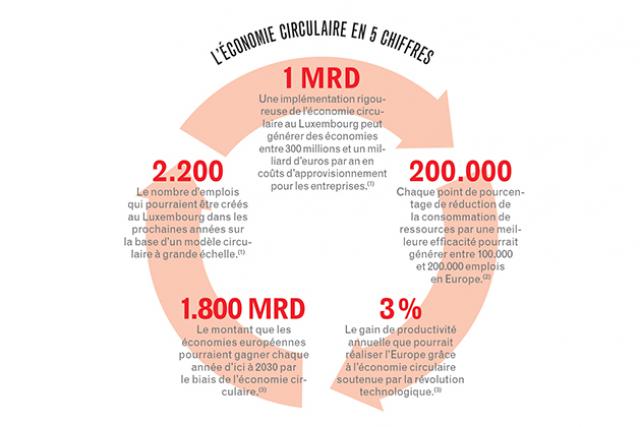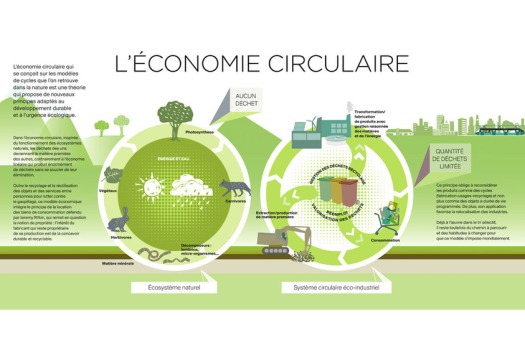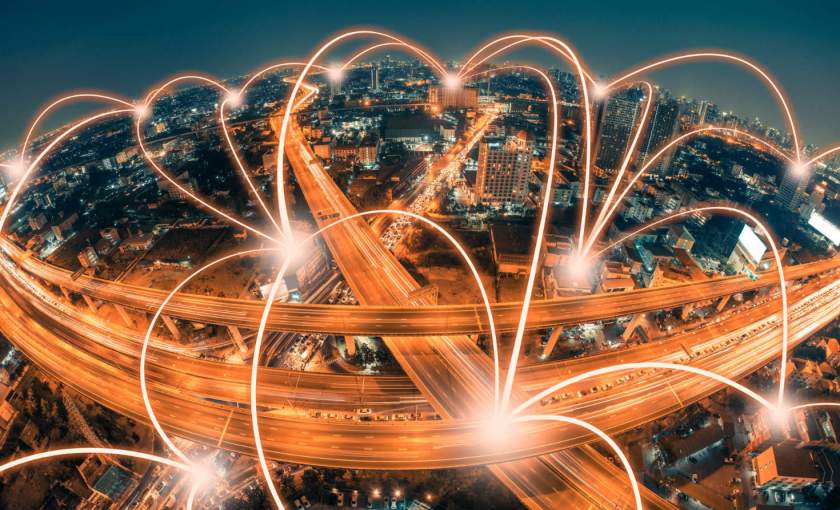Le compte à rebours est lancé. Dans six mois, presque jour pour jour, le Grand-Duché sera l’hôte du Luxembourg Circular Economy Hotspot 2017, un rendez-vous international qui réunira plus de 200 experts venant du monde entier. «Une belle opportunité pour le Grand-Duché de se positionner sur l’échiquier international», se réjouit d’avance la secrétaire d’État à l’Économie Francine Closener. «Cela contribuera sans doute à la promotion du Luxembourg comme un pays précurseur où de nouveaux modèles d’entreprises basés sur le principe du produit comme service deviennent peu à peu la norme.»
L’économie circulaire tourne bien au Luxembourg, et même si elle ne crève pas l’écran, les initiatives qui y sont liées sont de plus en plus nombreuses et spontanées. «On sent un décollage sur plein de niveaux. Les choses bougent et ce n’est pas un hasard si cette tendance apparaît de manière transversale dans l’étude Rifkin», constate Romain Poulles, président du Luxembourg EcoInnovation Cluster, qui sera le coordinateur de l’événement programmé du 20 au 22 juin 2017.«Le grand défi est d’être capable de repositionner l’Homme au cœur de toute initiative. Se demander ce qui est important pour lui avant d’entamer les réflexions sur la construction d’un bâtiment ou le lancement d’un service. La notion de ‘smart’ ne doit rien être d’autre qu’un ‘moyen au service de’. Parler de smart citizens plutôt que de smart cities et garder à l’esprit que l’ICT, par exemple, doit être au service de quelque chose et non pas une fin en soi.»
En février 2015, le gouvernement présentait une étude sur le potentiel de l’économie circulaire. «Depuis, il y a eu une évolution positive combinée à une prise de conscience générale, à la fois au niveau des entreprises, des citoyens et aussi au niveau du secteur public», note Francine Closener. Pour piloter et accompagner la mise en œuvre d’un plan d’action structuré, un groupe stratégique pour l’économie circulaire a été mis en place, qu’elle préside conjointement avec le secrétaire d’État au Développement durable et aux Infrastructures Camille Gira.
Parallèlement, les initiatives nationales se sont multipliées: le programme Fit4Circularity pour soutenir les PME dans leurs démarches; le développement du circular hot spot à Wiltz (avec une zone d’activités économiques, un quartier résidentiel, un bâtiment d’appartements, un Repair Café ou encore un Fab Lab…); le déploiement de quelque 100.000 compteurs intelligents afin de mesurer la consommation d’électricité et de gaz naturel et la réutilisation des «vieux» compteurs pour fabriquer de nouveaux produits; l’extension en cours de la zone d’activités économiques de Eselborn/Lentzweiler avec l’objectif de créer un guide des bonnes pratiques qui sera ensuite applicable à n’importe quelle autre zone d’activités… La liste est loin d’être exhaustive.
«Un des projets phares dont on ne parle pas beaucoup concerne le Luxembourg Automotive Campus de Bissen», ajoute Romain Poulles. «Un appel à candidatures vient d’être lancé pour la construction d’un bâtiment pilote qui rassemblerait toutes les fonctions communes du site: centre d’événement, salles de réunion, restauration, laboratoires communs… Ce sera une réalisation exemplaire en termes d’économie circulaire et, d’ailleurs, c’est tout le masterplan du site qui est en train d’être revu pour devenir ‘circulaire’.»
La multiplication des initiatives et des projets pilotes a également pour objectif de peaufiner les aspects juridiques, légaux ou techniques qui peuvent encore faire obstacle au déploiement d’un tel concept à grande échelle dans le pays. «À l’avenir, les pratiques de passation des marchés publics tiendront davantage compte des principes de l’économie circulaire», indique Mme Closener, attentive par ailleurs à ce que les autres pays font en la matière, et dans l’attente de l’annonce, par la Commission européenne, d’un train de mesures définitif sur l’économie circulaire.
Les entreprises aussi s’y mettent directement: Chaux de Contern propose désormais des services liés au revêtement; Astron développe un projet de parking à Esch en ayant pris des engagements fermes sur la récupération de la structure métallique à des prix fixés au départ, ce qui allège la facture du prêt pour les investisseurs… là encore, la liste est loin d’être exhaustive.
Quant aux communes, 2017 sera, pour certaines d’entre elles, une phase de tests dans le cadre du Pacte climat (que seule Weiswampach n’a pas signé) pour la mise en application de réflexions liées à l’économie circulaire selon plusieurs critères, entre autres l’économie de services, la réutilisation des ressources ou encore la flexibilité des bâtiments. Objectif: généraliser ces pratiques à partir de 2018. «Luxembourg sera alors le premier pays au monde à fournir un cadre pour développer et stimuler les idées de l’économie circulaire dans les communes», se réjouit d’avance Romain Poulles.
Le Grand-Duché a encore plus d’un tour dans son sac pour se différencier à l’échelle mondiale…
Jean-Christophe Delhaye
L’économie circulaire en cinq chiffres: 



Vous devez être connecté pour poster un commentaire.